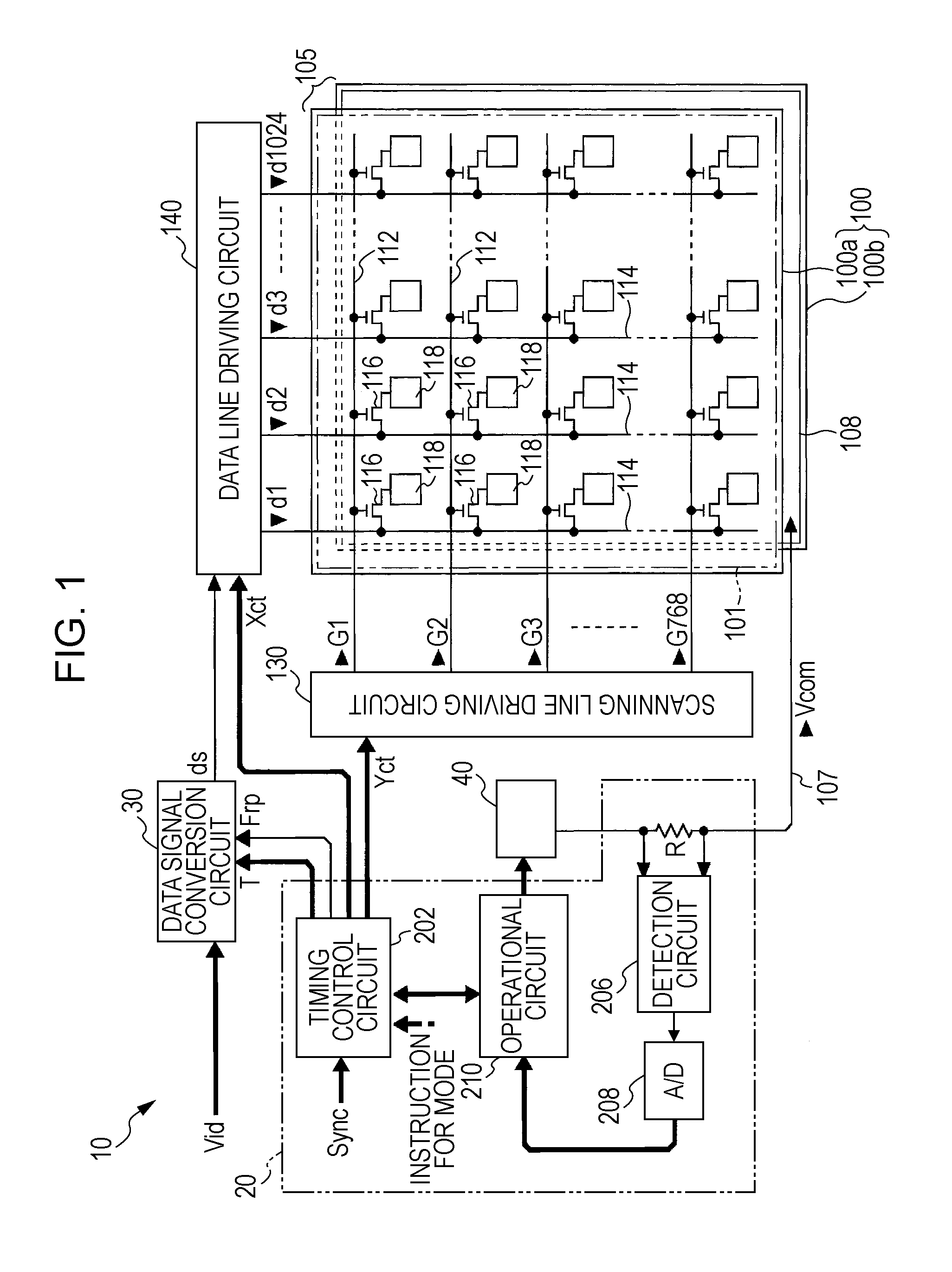Liquid crystal display, control method thereof and electronic device with reduced flicker
a technology of electronic devices and liquid crystal displays, applied in the direction of instruments, computing, electric digital data processing, etc., can solve the problem of difficult to detect transmittance accurately, and achieve the effect of suppressing the application of dc components and reducing flicker
- Summary
- Abstract
- Description
- Claims
- Application Information
AI Technical Summary
Benefits of technology
Problems solved by technology
Method used
Image
Examples
first embodiment
[0027]To begin with, a first embodiment of the invention will be described in outline.
[0028]In order to prevent seizing or deterioration of liquid crystal, an AC driving is required to be performed for a liquid crystal element in which a liquid crystal layer is sandwiched by a first electrode and a second electrode. For example, a voltage with positive polarity higher than a reference voltage (higher voltage) and a voltage with negative polarity lower than the reference voltage (lower voltage) are alternately applied to the first electrode, while a predetermined voltage is applied to the second electrode. At this time, if transmittance (or reflectance) in the liquid crystal element at a period where the voltage is applied and kept positive is different from that in the liquid crystal element at a period where the voltage is applied and kept negative, this makes flicker (blink) recognized.
[0029]Liquid crystal molecules alter their inclined arrangement depending on the electric field ...
second embodiment
[0116]Next, a second embodiment of the invention will be described. The second embodiment is the same as the first embodiment except that waveforms for the scanning signals G1 to G768 in the adjustment mode in the first embodiment are as shown in FIG. 7A.
[0117]In detail, in the adjustment mode in the second embodiment, the scanning signals G1 to G768 have the H level only for the time s from the start timings of the respective durations Ta, Tb, Tc, and Td and the L level for the remaining time.
[0118]As described above, the driving voltage for the liquid crystal element 120 is instantaneously varied relative to the voltage applied to the pixel electrode 118, and thereby although the scanning signal has the H level only for the time s, the difference between the voltage of the data signal and the voltage of the common signal is enough to be maintained in the liquid crystal elements 120.
[0119]Meanwhile, in the display mode, when the TFT 116 is turned on and thereafter turned off, there...
third embodiment
[0123]A third embodiment of the invention will be described. In this third embodiment, as shown in FIG. 8, an LPF (low pass filter) 207 which passes only a low frequency component of the output signal of the detection circuit 206 is employed, and further the scanning line driving circuit 130 performs a line sequential driving in which the scanning lines are selected in the same order as the display mode without differentiation depending on the operation modes, as shown in FIG. 9A.
[0124]In such a line sequential driving, the waveform of the current flowing through the signal line 107 (more accurately, the waveform of the voltage converted from the current) is obtained by overlapping the respective current waveforms caused by the selection of each scanning line, that is, the respective current waveforms appearing when the scanning signals G1, G2, G3, . . . , and G768 become the H level, as shown in FIG. 9B wherein the current waveform is determined by a selection of each row. The inst...
PUM
 Login to View More
Login to View More Abstract
Description
Claims
Application Information
 Login to View More
Login to View More - R&D
- Intellectual Property
- Life Sciences
- Materials
- Tech Scout
- Unparalleled Data Quality
- Higher Quality Content
- 60% Fewer Hallucinations
Browse by: Latest US Patents, China's latest patents, Technical Efficacy Thesaurus, Application Domain, Technology Topic, Popular Technical Reports.
© 2025 PatSnap. All rights reserved.Legal|Privacy policy|Modern Slavery Act Transparency Statement|Sitemap|About US| Contact US: help@patsnap.com



